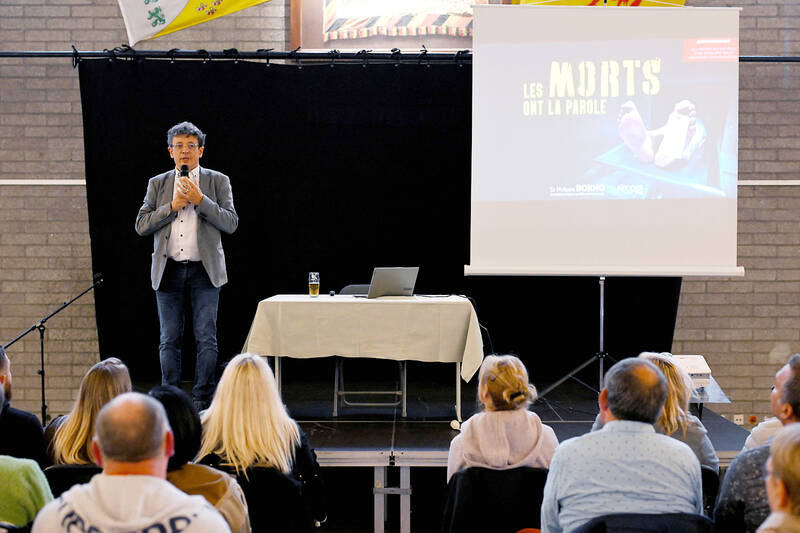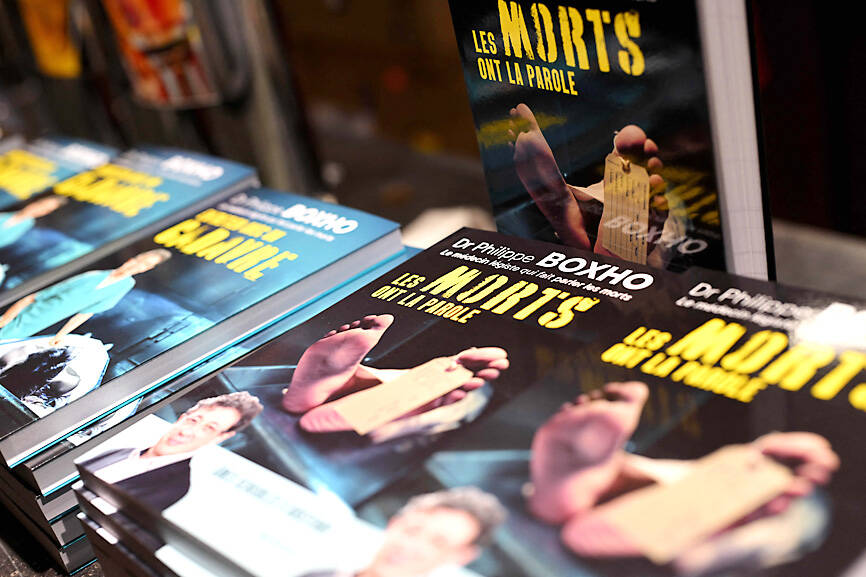Forensic pathologist Philippe Boxho likes to ask people “why shouldn’t we laugh about death?” But gallows humor is just one of the ingredients that the surprise literary sensation brings to his macabre line of storytelling.
In 33 years as a medical examiner in Belgium’s eastern Liege region, Boxho has performed hundreds of autopsies — his attention to detail bringing to light homicide cases that would otherwise have remained undetected.
Boxho has become a surprise star of the book world in Belgium and France, distilling his unusual line of work into taut collections of short stories, each one 15 pages or less.

Photo: AFP
Anchored in real life, the writing is unflinching and darkly-humorous, but the 59-year-old Boxho also seeks to impart some of his passion for a little-known, but crucial, profession.
The enthusiasm is palpable as the pathologist described the “excitement of being there at the start of an investigation,” of pulling on his sturdy dishwashing gloves and white coveralls to begin working.
It’s a way, he said of his work, “to give voice to the dead one last time.”

Photo: AFP
Boxho’s observations have revealed the most unusual of circumstances for a person’s demise — like the 60-something woman who had her throat slashed by her son’s pitbull terrier, that she had exceptionally gone to feed.
Another time he established how a farmer was trapped by a bull he did not see surge from the stable shadows. Multiple fractures to the torso and limbs showed how the hapless victim was crushed by a beast weighing in at 1.2 tonnes.
The idea of writing came to Boxho in 2021, triggered by the success of a post by Belgian channel RTBF, in which he recounted three striking anecdotes.
Encouraged, he decided to set down in writing more of the stories pulled from his more than three decades in forensics — which until then had been shared only with students at the medical school where he teaches.
It was an instant hit: published almost back-to-back, his three books have together sold some 740,000 copies, including almost 200,000 for the latest one released in late August, whose title translates as “Looking death in the face.”
“It’s extraordinary for a work of non-fiction,” said a spokesperson for Kennes, a small Belgian publisher that was struggling to make ends meet until it struck gold with Boxho.
In France, his latest book is among the season’s non-fiction bestsellers, with talks underway on an English edition of his work.
’I RESPECT THE BODY’
At a book-signing event at a former mining site in Blegny, near Liege, Boxho drew a full house of enthusiasts.
“It’s fascinating to hear him talk because he’s passionate about what he does,” said Marie Lou Collard, a political science student who was among the readers in the audience.
She came across Boxho via his videos posted on TikTok and YouTube, and sought out his essays to find out more.
In all of Boxho’s real-life stories, dating back sometimes decades, the identities have been changed in keeping with medical confidentiality rules.
“I respect the body I have in front of me,” Boxho said. “It belongs to a person I don’t know.”
“What I laugh about is death and the ways that people die,” he said. “It’s a bit cynical, but that’s the way I am. If you don’t like it, don’t read my books.”
Many of his cases have involved women killed by their partners. Sometimes it is a parent killed by a child — or almost killed, as in one extraordinary case Boxho shared with the crowd in Blegny.
Late one night, a woman entered her father’s bedroom with a revolver, intent on murdering him. She fired the entire barrel at him, and left him for dead.
But the autopsy later showed the suspected murder victim was already dead when she shot him — of a brain hemorrhage that occurred just moments earlier — and the daughter was cleared as a result.
“Criminal law requires certainties,” said Boxho, who argued that defending his profession, whose numbers have dwindled dramatically in recent years in Belgium, is also a way of ensuring better justice for all.

May 11 to May 18 The original Taichung Railway Station was long thought to have been completely razed. Opening on May 15, 1905, the one-story wooden structure soon outgrew its purpose and was replaced in 1917 by a grandiose, Western-style station. During construction on the third-generation station in 2017, workers discovered the service pit for the original station’s locomotive depot. A year later, a small wooden building on site was determined by historians to be the first stationmaster’s office, built around 1908. With these findings, the Taichung Railway Station Cultural Park now boasts that it has

The latest Formosa poll released at the end of last month shows confidence in President William Lai (賴清德) plunged 8.1 percent, while satisfaction with the Lai administration fared worse with a drop of 8.5 percent. Those lacking confidence in Lai jumped by 6 percent and dissatisfaction in his administration spiked up 6.7 percent. Confidence in Lai is still strong at 48.6 percent, compared to 43 percent lacking confidence — but this is his worst result overall since he took office. For the first time, dissatisfaction with his administration surpassed satisfaction, 47.3 to 47.1 percent. Though statistically a tie, for most

Wooden houses wedged between concrete, crumbling brick facades with roofs gaping to the sky, and tiled art deco buildings down narrow alleyways: Taichung Central District’s (中區) aging architecture reveals both the allure and reality of the old downtown. From Indigenous settlement to capital under Qing Dynasty rule through to Japanese colonization, Taichung’s Central District holds a long and layered history. The bygone beauty of its streets once earned it the nickname “Little Kyoto.” Since the late eighties, however, the shifting of economic and government centers westward signaled a gradual decline in the area’s evolving fortunes. With the regeneration of the once

In February of this year the Taipei Times reported on the visit of Lienchiang County Commissioner Wang Chung-ming (王忠銘) of the Chinese Nationalist Party (KMT) and a delegation to a lantern festival in Fuzhou’s Mawei District in Fujian Province. “Today, Mawei and Matsu jointly marked the lantern festival,” Wang was quoted as saying, adding that both sides “being of one people,” is a cause for joy. Wang was passing around a common claim of officials of the People’s Republic of China (PRC) and the PRC’s allies and supporters in Taiwan — KMT and the Taiwan People’s Party — and elsewhere: Taiwan and